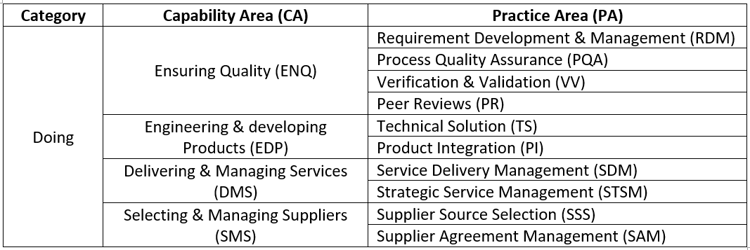In my previous blogs on CMMI I had talked about CMMI structure, and categories like Doing, Managing, Enabling, and Improving. In these blogs, we briefly talked about various capability areas under each category.
Let us understand the links between the Capability areas and Practice areas to conclude this series in understanding the CMMI structure. I am limiting the explanation for the Development constellation or view of this module.
To start with, in this blog, we will discuss Practice Areas in the Doing category.

CA - Ensuring Quality (ENQ) How can we ensure expected quality is built and delivered to the customer? Practice Areas in this capability area provide guidance.
- PA - Requirement Development & Management (RDM) – It is important to know what customers expect? To know that, we need to gather these requirements. Sometimes customers have a concept and requirements are not ready. This is a tricky situation and business analysts need to apply expertise to elicit these requirements by using a variety of elicitation techniques to gather them from the customer.
- PA - Process Quality Assurance (PQA) – To deliver the product or service, processes established in the organization are followed. Results are delivered through the processes. The organization must evaluate these processes objectively to assure results are delivered as expected. These evaluations are carried out to check process and defined standards implementation, the performance of established processes, and resulting work products.
- PA - Verification and Validation (VV) – It is mandatory to ensure that products or services to be delivered to the customer meet their requirements and they will perform according to the intended use at the customer end. To conform organization needs to check two aspects:
1. Are we building it right?
2. Are we building the right thing?
While getting a job done in the organization various reviews are conducted to verify the team is doing the right things. These reviews are performed at every stage of the development lifecycle. They are in the form of testing, analysis, inspection, demonstrations, or simulation.
Validation is performed to ensure the right solution is built. Typically, in the validation activities, end-users and affected stakeholders get involved. - PA -Peer Reviews (PR) – This is a part of the verification activity and in the previous model 1.3 was part of the Verification and Validation (VV) activities. The CMMI model has separated this specific practice from VV and identified it as a separate practice area. That indicates the importance given to these reviews. It is expected that these reviews are carried out by the Peer of the person involved in the activity or by a Subject Matter Expert (SME). Peers or SMEs methodically and objectively examine the work products by using techniques like inspections, structured walkthroughs, audits, etc. These reviews help to identify and eliminate issues at an early stage.
CA – Engineering & Developing Products (EDP) – How can an organization demonstrate the ability to design, and implement this design to develop the product or service, which meets customer requirements? Practice Areas in this capability area provide guidance.
- PA – Technical Solutions (TS) – To deliver products or services to the customer, organizations need to put efforts into architecting and designing, which meet customer requirements. Requirements being an input activity are performed in designing and building the solutions. These activities are performed at any level for the design of product or product components, Services, service systems, and service components. These designs must meet customer, functional, and quality requirements. Organizations evaluate various suitable alternatives and implement them. We will discuss the DAR practice area later, which is used for evaluating alternatives. Organizations implement the evaluated design as a product or service or component.
- PA - Product Integration (PI) – Once the design of the product or solution is complete then implementation starts. Various components are developed based on the design and later they are integrated into the final solution. Like any manufacturing organization, various components are machined, brought together for sub-assemblies, and later are integrated as a final product in the final assembly. All these integrations into the final product must meet the functionality and quality requirements of the customer. Organizations must define integration strategies, depending on complexity, integrate the solution in one go or have iterative builds and verify and validate each build or assembled components.
I know this is getting a bit technical and difficult to grasp however I will try to make it as simple as I can.
I will write separate blogs for the remaining two Capability Areas, Delivering and Managing Services (DMS) and Selecting & Managing Suppliers (SMS) later as we will discuss the Development view or constellation of the CMMI model.









